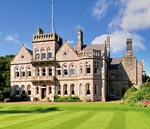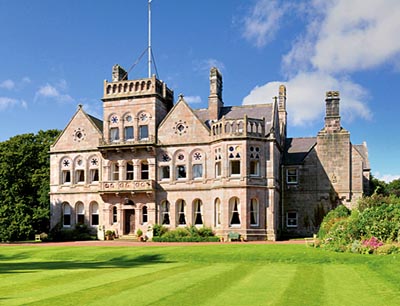Great estates in Northumberland
Northumbrians tend to hang onto their country houses so the launch of Cheswick House and Harehope Hall is a cause for celebration


Once the most dangerous and lawless part of England, the wild and beautiful border area of north Northumberland is now one of the most peaceful, where new arrivals can enjoy a country lifestyle that is both traditional and progressive, thanks in no small measure to the long-term efforts of its farmers and landowners.
The survival of Northumberland's great estates is also the reason why few important country houses ever come to the market in this part of the world, which makes the sale of the handsome, Victorian-Gothic Cheswick House, five miles south of Berwick-upon-Tweed, at a guide price of £2.25 million through Sale & Partners (01668 281611), all the more compelling for aspiring Northumbrians.
Cheswick House, listed Grade II, was built by wealthy Berwick brewer Robert Crossman in 1859 as the principal house on his Cheswick estate, which overlooks Holy Island, where he was also Lord of the Manor. The ornate stone house was designed by the Church architect F. R. Wilson, who worked with Charles Barry on the Houses of Parliament before moving to Alnwick as site architect to Anthony Salvin during the remodelling of the Duke of Northumberland's Alnwick Castle.
The Cheswick and Holy Island estates passed through successsive generations of the Crossman family, all of whom had distinguished military careers before playing a hands-on role not just in the running of their estates, but also in the life of the county as magistrates, High Sheriffs, county councillors and conservationists.
The last of the Crossmans to live at Cheswick House was the late Lt Col Humphrey Crossman, who settled there on retiring from the army in 1970. He, too, threw himself into county affairs, becoming a Freeman and Mayor of Berwick, regional secretary of the Northumberland and Durham CLA, High Sheriff of Northumberland and Deputy Lieutenant of the county. Sadly, having lost his only son, David, in a tragic accident in Africa in 1997, there was no one to take on the family seat, and he and his wife had already moved to a smaller house on the estate by the time Cheswick House came to the market, for the first time ever, in 2002.
For years, Northumberland-based land surveyor Peter Bennett and his wife, Jean, an archaeologist, had been looking for just such a perfect ‘time capsule' to renovate, and the sale of Cheswick House, in its unique setting overlooking the beaches of Northumbria's heritage coast and the Cheviot Hills, was a rare opportunity, too good to miss. At the same time, the house was wonderfully private, being protected from the elements and the outside world by 30 acres of woodland, gardens, and paddocks, and enclosed by an estate wall.
The couple immediately embarked on a major renovation of the house, garden wing, gardener's cottage and gate lodge, sifting through a succession of local craftsmen to revive the fabric of the building, upgrade and modernise the interior and bring the somewhat antiquated heating and plumbing systems up to scratch. Designer Gillian Drury of Belford Interiors in nearby Belford was brought in to advise on colours, soft furnishings and period wallpapers many of which were specially commissioned. Mrs Bennett took on the restoration of the formal gardens-described as ‘a gardener's dreams come true'-which include a walled garden, a secret garden, a new water garden and a remarkable ‘curling pond garden' that was created on the site of a former underground Victorian curling rink-one of few to be built this side of the border.
Sign up for the Country Life Newsletter
Exquisite houses, the beauty of Nature, and how to get the most from your life, straight to your inbox.

* Subscribe to Country Life and get the Ipad edition at no extra cost
With its four splendid reception rooms (the drawing room and dining room, with their ornate coffered ceilings, are particularly impressive) a bespoke family kitchen, master and guest suites, five further bedrooms and three bathrooms, Cheswick House is undeniably grand, but is still a warm and welcoming family home-much cherished by the Bennetts and their four children, who have now reluctantly left the nest.
A country estate in miniature, with access to hunting with the West Percy and the North Northumberland and fishing on the nearby River Tweed, the property includes the original stable courtyard with 15 acres of paddocks that could form the basis of a serious equestrian unit, backed up by a regular income from holiday lets.
The Cresswells have been major landowners in north Northumberland since the time of King John, and it was they who, in 1848, built Harehope Hall at Eglingham, nine miles north-west of Alnwick, as a sporting lodge on the family's Harehope estate. Harehope Hall and its estate are now owned by the Wrangham family, the hall being the home of John Wrangham and his wife, Ali, whose children have also grown up and left home.
Regretfully, they have decided to downsize and move to a farmhouse elsewhere on the estate, and Harehope Hall, which is unlisted, is being offered with its lodge, stone stable block and outbuildings, extensive gardens, three acres of paddocks, 53 acres of woodland and 26 acres of farmland, at a guide price of £2.1m, also through Sale & Partners (01668 281611).
Like Cheswick House, Harehope Hall-with its grand entrance hall, three fine reception rooms including a spectacular dining room, sandstone staircase and ornate decorative ceilings-exudes Victorian splendour. The main house also has a large family sitting room and kitchen, nine bedrooms and four bathrooms. The adjoining four-bedroom Cresswell Wing, which has its own private access, could generate a useful source of income from holiday lets.
The gardens and wooded grounds that slope gently southwards and are mostly laid to terraced lawns give a sense of sheltered seclusion to the hall, and include an outdoor heated pool, well used during the summer months. The paddocks provide grazing, and the woodland is a haven for wildlife, including roe deer and red squirrels, with the farmland to the south further protecting the owner's privacy and the glorious views over the surrounding countryside.
Country Life is unlike any other magazine: the only glossy weekly on the newsstand and the only magazine that has been guest-edited by HRH The King not once, but twice. It is a celebration of modern rural life and all its diverse joys and pleasures — that was first published in Queen Victoria's Diamond Jubilee year. Our eclectic mixture of witty and informative content — from the most up-to-date property news and commentary and a coveted glimpse inside some of the UK's best houses and gardens, to gardening, the arts and interior design, written by experts in their field — still cannot be found in print or online, anywhere else.
-
 RHS Chelsea Flower Show: Everything you need to know, plus our top tips and tricks
RHS Chelsea Flower Show: Everything you need to know, plus our top tips and tricksCountry Life editors and contributor share their tips and tricks for making the most of Chelsea.
By Amie Elizabeth White Published
-
 Hidden excellence in a £7.5 million north London home
Hidden excellence in a £7.5 million north London homeBehind the traditional façades of Provost Road, you will find something very special.
By James Fisher Published
